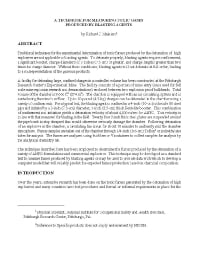Mining Publication: A Technique for Measuring Toxic Gases Produced by Blasting Agents
Original creation date: January 1997
Authors: RJ Mainiero
NIOSHTIC2 Number: 20025380
Proc 23rd Annual Conference on Explosives and Blasting Technique. Cleveland, OH: International Society of Explosives Engineers, 1997 Jan; :595-604
Traditional techniques for the experimental determination of toxic fumes produced by the detonation of high explosives are not applicable to blasting agents. To detonate properly, blasting agents require confinement, a significant booster, charge diameters of 3 inches (7.5 cm) or greater, and charge lengths greater than two times the charge diameter. Without these conditions, blasting agents will not detonate at full order, leading to a misrepresentation of the gaseous products. A facility for detonating large, confined charges in a controlled volume has been constructed at the Pittsburgh Research Center's Experimental Mine. The facility consists of a portion of mine entry (once used for full scale mine explosion research and demonstrations) enclosed between two explosion proof bulkheads. Total volume of the chamber is 9,666 ft (274 m ). The chamber is equipped with an air circulating system and is vented using the mine's airflow. Up to 10-pound (4.5-kg) charges can be detonated in the chamber using a variety of confinements. For a typical test, the blasting agent is confined in a 4-inch (10-cm) schedule 80 steel pipe and initiated by a 3-inch (7.5-cm) diameter, 1-inch (2.5-cm) thick Pentolite booster. This combination of confinement and initiation yields a detonation velocity of about 4,000 m/sec for ANFO. This velocity is in line with that measured for blasting in the field. Twenty four 2-inch thick steel plates are suspended around the pipe bomb to stop shrapnel that would otherwise seriously damage the chamber. Following detonation of an explosive in the chamber, a circulating fan is run for about 10 minutes to uniformly mix the chamber atmosphere. Fumes samples are taken out of the chamber through 1/4-inch (0.6-cm) Teflon or polyethylene tubes for analysis. The fumes are analyzed using bubblers or Vacutainers to collect samples for analysis by the analytical chemistry lab. The technique described here has been employed to determine the fumes produced by the detonation of a variety of ANFO formulations and commercial explosives. This technique may be developed as a standard test to measure fumes produced by blasting agents or may be used to provide data with which to develop a computer model that will reliably predict the expected fumes production based on chemical composition.

NIOSHTIC2 Number: 20025380
Proc 23rd Annual Conference on Explosives and Blasting Technique. Cleveland, OH: International Society of Explosives Engineers, 1997 Jan; :595-604
- Blasting and Explosives
- Chemical and Physical Factors that Influence N0x Production During Blasting: Exploratory Study
- Dangers of Toxic Fumes from Blasting
- Factors Affecting Fumes Production of an Emulsion and ANFO/Emulsion Blends
- Field Studies of CO Migration from Blasting
- A Gas Pressure-Based Drift Round Blast Design Methodology
- The Limiting Oxygen Concentration and Flammability Limits of Gases and Gas Mixtures
- Monitoring and Removal of CO in Blasting Operations
- Toolbox Training on Flyrock Awareness
- Toxic Fume Comparison of a Few Explosives Used in Trench Blasting